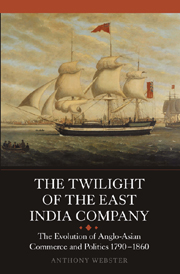 The Twilight of the East India Company
The Twilight of the East India Company Book contents
- Frontmatter
- Contents
- Preface
- 1 Introduction: The end of the East India Company, the historians and the evolution of Anglo-Indian commerce and politics
- 2 The origins of the East India Company and the rise of non-Company commercial interests in Britain, India and Asia, 1600–1793
- 3 War, politics and India: The battle for the East India Company trade monopoly, 1793–1813
- 4 Accommodating free trade: India, the East India Company and the commercial revolution of 1814–1830
- 5 Crisis and trade liberalisation 1830–1834: Financial chaos and the end of the East India Company's commercial role and privileges
- 6 Re-ordering Anglo-Asian commerce and politics: 1833–1847
- 7 Crisis, the resurgence of London and the end of the East India Company: 1847–1860
- 8 Conclusion: The decline of the East India Company and the evolution of British commercial and political interests in Asia, 1793–1860
- Notes
- Bibliography
- Index
7 - Crisis, the resurgence of London and the end of the East India Company: 1847–1860
Published online by Cambridge University Press: 12 September 2012
- Frontmatter
- Contents
- Preface
- 1 Introduction: The end of the East India Company, the historians and the evolution of Anglo-Indian commerce and politics
- 2 The origins of the East India Company and the rise of non-Company commercial interests in Britain, India and Asia, 1600–1793
- 3 War, politics and India: The battle for the East India Company trade monopoly, 1793–1813
- 4 Accommodating free trade: India, the East India Company and the commercial revolution of 1814–1830
- 5 Crisis and trade liberalisation 1830–1834: Financial chaos and the end of the East India Company's commercial role and privileges
- 6 Re-ordering Anglo-Asian commerce and politics: 1833–1847
- 7 Crisis, the resurgence of London and the end of the East India Company: 1847–1860
- 8 Conclusion: The decline of the East India Company and the evolution of British commercial and political interests in Asia, 1793–1860
- Notes
- Bibliography
- Index
Summary
IN THE mid-1840s countries all over Europe were plunged into severe turmoil. Poor harvests and a general downturn in international trade, which was exacerbated by financial panics which spread rapidly across the continent, created the worst political and economic crisis since the end of the Napoleonic Wars. Abortive revolutions in Germany and France in 1848 revived memories of 1789 and 1830. Even Britain, the world's leading economic and imperial power, was rocked by the severity of the depression. Bankruptcies, rising unemployment, poverty, famine in Ireland, Chartist agitation and the rise of the anti-Corn Law league buffeted the political establishment. The Repeal of the Corn Laws by Robert Peel's Tory administration split the party and ushered in decades of Whig/Liberal political and intellectual dominance. The crisis reached its peak in 1847/8 when a wave of failures and bankruptcies swept through Britain's major cities, hitting the City of London particularly hard. The Irish famine and a succession of poor harvests bankrupted a number of corn merchants in the summer of 1847, particularly in Liverpool. Excessive speculation in railway construction in the early 1840s also contributed to the crash. The full severity of the crisis became apparent in September 1847 when the London merchant firm of Messrs Gower, Nephews & Co. failed, to be followed by scores of failures in London, Liverpool, Glasgow, Manchester and elsewhere throughout the autumn.
- Type
- Chapter
- Information
- The Twilight of the East India CompanyThe Evolution of Anglo-Asian Commerce and Politics, 1790–1860, pp. 129 - 150Publisher: Boydell & BrewerPrint publication year: 2009


